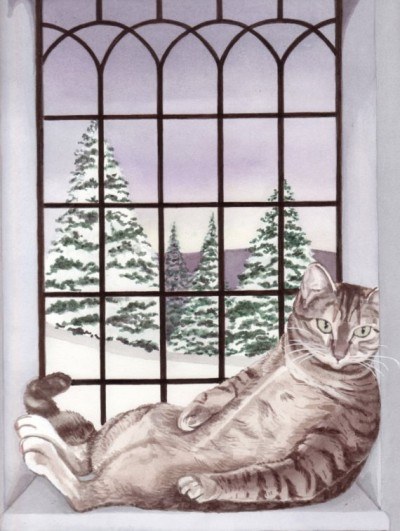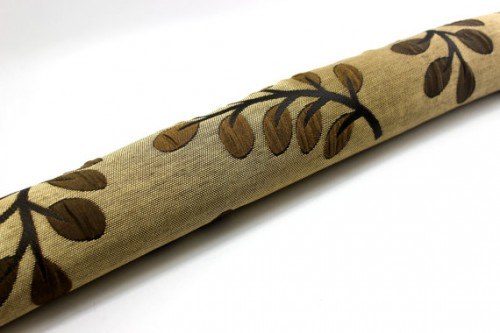
Even though Ukrainian winter was comparatively mild in Odessa, still every November my grandmother was adamant about how to keep the cold out. F.Y.I., of course, we didn’t have any tools at all. So we used rolled newspaper (yep, that was in Ukraine in the eighties) as draft stoppers. Sometimes, it was cotton balls stuffed between the two panes of window glass and lovingly decorated with glitter and plastic toys. Honestly, it all looked cheesy but it helped to keep the cold out to some extent. After so many years, I could still use the same principles as my Ukrainian grandmother.
So, how to keep the cold out now?
1. Use draft stoppers. Here are some ways to reduce drafts this winter:
Make a draft stopper by following the technique as described in The Little House in the City blog post.

Or buy a draft stopper if you prefer a ready-made option.
Woven Cotton Silk is a strong fabric and it’s a rather pretty draft stopper which adds tons of luxury and style. Cost $14.99.
2. Fabric Draperies. How to make your fabric draperies work for your money by reducing air leaks.
To make your draperies work for your money you need to think about creating a window envelope so that there is a minimum amount of air leaks. Fabric draperies that open and close covering the whole window are ideal.
Add fabric for returns (sides) of the drapery
Make sure that your draperies have a side return. It is usually 4-5 inches. They have to be as close to the wall as possible to minimize air leaks. The length of the curtain has to be all the way to the floor. For maximum effectiveness install a cornice at the top of drapery to close the “envelope.”
Use a thermal lining to reduce the drafts
Fabric draperies with factory-made thermal lining work the best. They are quite common in England. Apparently, before replacement windows were an option the interlinings came into being. An interlining is an additional layer of lining. It was so unique to the American tourists when they saw it that they ended up creating a demand for heavy interlinings in America as well.

Types of Curtain Lining
1. Enhance Lining A step up from a regular cotton lining. An excellent alternative to interlining if you don’t want the two layers of lining+interlining. But if it is combined with interlining you’ve got 80% improvement in R-value over unlined draperies.
2. Interlining is versatile, economical and works well with most treatments and styles adding body & weight.
3. Fusion Sateen 50% cotton– 50% polyester with a fused interlining on the back. Excellent thermal and noise insulation.
4. Flannel is heavier than regular interlining. It adds weight to your curtains and drapes.
3. Window shades
Window shades can be one of the simplest and most effective window treatments if you are wondering how to keep the cold out.
Tip:
Shades should be mounted as close to the glass as possible to establish a sealed air space.
Honeycomb shades make a difference in energy savings.
Duette® Architella® shades by Hunter Douglas help insulate homes and reduce energy consumption due to their patented honeycomb-within-a-honeycomb construction. Vignette® Tiered™ Architella® Shades by Hunter Douglas features rear fabric air pockets that trap the air and create an extra layer of insulation.
Budget-friendly options to reduce the drafts and keep you warm
If custom energy-efficient window treatments are not in your budget, there are some ready-made affordable options to consider.
- Curtainworks energy savings draperies and curtains that provide many options for fabrics with thermal and light control. Some of the benefits include light filtration and room darkening as well as energy savings.
- Warm Window® System by Cozy Curtains. According to the manufacturer’s description, the Warm Windows system consists of several layers that are designed to reduce the flow of energy through the window glass. The final layer that faces the room is a decorative fabric that you choose.
More Tips on how to keep the cold out
- Keep all the doors to the rooms that you do not use closed. The most draft comes from the garage, so keeping the door closed will help prevent the cold air from moving into the rest of the house.
- Close any unused rooms. A closed room will act as another barrier between you and the cold outside.
- Add draft snake, V-seal weather stripping, rope caulk, fill cracked panes or outlet seals. All of these products are quite inexpensive and range between $3- 6 per window.
Please post your questions here below. I’ll be happy to help you!



